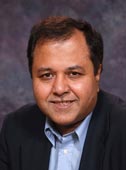Aberrant Signaling and Metabolism in Malignant Brain Tumours

Ab Guha, winner of the
Lister Prize
|
Joseph Lister worked patiently on controlling the development
of osteomyelitis in open fractures
through application of
the scientific method. He knew
Pasteur's method of using heat
to kill bacteria would not be
safe, so he experimented with
antiseptics. The Lister Prize is
awarded to a senior investigator
in our department who has
shown outstanding and continuing
productivity of international stature. Ab Guha
has been working patiently to understand the molecular
basis of malignant brain tumors, with the hope this
knowledge will lead to novel therapies. Here's how Ab
told the story at a recent University Rounds.
After thanking his family, mentors, colleagues and lab
members, Ab praised the Surgeon Scientist Program and
the culture of academic excellence in surgery he experienced
during his training and later as he mentors the
next generation of surgeon-scientists.
Ab's research has focused on the molecular basis of primary
malignant brain tumours, the most common of
which is the Glioblastoma Multiforme (GBM). GBMs
occur in ~12/100,000 people. Despite treatment by
surgery, radiation and chemotherapy, the median survival
remains 12-16 months. There are two or more
ways that a GBM can arise. Though pathologically
indistinguishable, they harbour molecular differences
including overexpressed and/or mutated growth factor
receptors and intracellular signaling pathways. Ab's
research has focused on two of these aberrant receptors
(PDGFR- Platelet Derived Growth Factor Receptor;
EGFR- Epidermal Growth Factor Receptor), which have
been shown to be overexpressed and activated, leading to
increased tumorgenic signals. Biological
|
therapies, based
on pre-clinical work by Ab and others, has led to clinical
trials with drugs that inhibit these receptors. Since
GBMs are not driven by a single genetic alteration, Ab
predicted targeting one receptor or pathway will likely
not succeed, and will require therapies against multiple
targets.
Ab's work has demonstrated activation of Ras, a key
intracellular signaling pathway from these receptors,
which carries tumorigenic signals to the cell's nucleus.
Therapies inhibiting this pathway are under clinical
trials. Ab's lab has developed transgenic mouse brain
tumour models, based on the molecular alterations
found in human GBMs. These models have been used to
examine interactions between these molecular alterations
to determine which are driving the tumour growth and
which are bystander alterations, which ones initiate the
tumour vs. which ones makes them progress. In addition
to testing the relevance of the known molecular alterations,
these mouse models, can also be used to discover
new genetic alterations in human tumours. Ab stressed
the point about the critical node that surgeon-scientists
hold in tumour banking and facilitating their own
research, and the work of other basic scientists who do
not have ready access to these precious clinical materials.
Ab described how tumours utilize glucose for energy vs.
normal cells. In tumours such as GBMs, energy is derived
from glycolysis outside the mitochondria. Although less
efficient in making ATP this form of glucose utilization
allows the tumour cells to survive and accumulate building
blocks of further growth, including lipids, aminoacids
and nucleic acids. Ab's group has demonstrated
the enzyme Hexosekinase2 to be an important mediator
of abnormal glucose metabolism in human GBMs.
Pharmaceutical companies are increasingly interested in
targeting these aberrant metabolic pathways in tumours
as potential anti-cancer agents.
Ab wrapped up his talk with a forward look at the field
of neuro-oncology to which he and his colleagues have
made significant contributions.
|